CM601: Amnisos, Port of Minoan Crete
David Noel
<davidn@aoi.com.au>
Ben Franklin Centre for Theoretical Research
PO Box 27, Subiaco, WA 6008, Australia.
Amnisos and the Minoans
The Minoans were an advanced civilization centered on the Mediterranean island of Crete. They flourished well before the Greeks and the Romans, and were contemporary with some of the well-known kingdoms of the Pharaohs of Egypt.
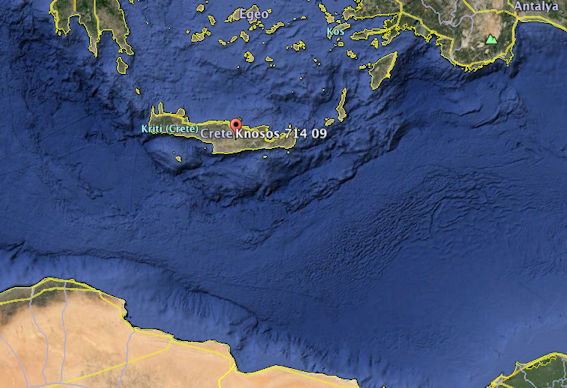
Figure CM601-F1. The island of Crete and the surrounding seafloor. From [2]
However, in contrast with the Egyptians, the Minoans are not well-known as an ancient civilization. This may be partly because their civilization is very old, and also because much of it was wiped out in a cataclysmic explosion and tidal wave, around 3500 years ago, in 1500 BC.
Here is an extract on what Wikipedia says about the Minoans [1].
"The Minoan civilization was an Aegean Bronze Age civilization that arose on the island of Crete and other Aegean islands and flourished from approximately 3650 to 1400 BCE. It belongs to a period of history preceding both the Mycenaean civilization and Ancient Greece.
It was rediscovered at the beginning of the 20th century through the work of British archaeologist Arthur Evans. Their civilization has been referred to as the earliest of its kind in Europe.
The term 'Minoan' refers to the mythic King Minos, and was originally given as a description to the pottery of this period. Minos was associated in Greek myth with the labyrinth and the Minotaur, which Evans identified with the site at Knossos, the largest Minoan site. The poet Homer recorded a tradition that Crete once had 90 cities".
It is believed that the Greek poet Homer was born sometime between the 12th and 8th centuries BC, possibly somewhere on the coast of Asia Minor [4]. He is famous for the epic poems The Iliad and The Odyssey, which have had an enormous effect on Western culture, but very little is known about their alleged author.
It is in The Odyssey, the epic tale which Homer wrote about the travels of the legendary ancient figure Odysseus, that we can first find mention of King Minos and the bull-monster he controlled (Minotaur) at his palace in Knossos. For Homer, The Odyssey amounted to historical fiction -- he was writing about legendary figures, folk tales which had come down to him from his past.
The Odyssey is written in the first person, with Homer imagining Odysseus recounting his travels and adventures. At one point in these tales, Odysseus has returned to his home after many years and hears that his wife is in a difficult situation. He disguises himself as a traveller called Aethon and calls on his wife in this disguise. Here is the passage from The Odyssey [3].
"Resourceful Odysseus replied: 'Honoured wife of Odysseus, Laertes' son, must you ask me of my lineage? Very well, I will tell you, though you only add more pain to that I already suffer, as is ever the case when a man has been as long away from home as I have, roaming sadly from city to city. Nevertheless I will answer your questions.
Out in the wine-dark sea lies a land called Crete, a rich and lovely island. It is filled with countless people, in ninety cities. They are not of one language, but speak several tongues. There are Achaeans there, and brave native Cretans, Cydonians, three races of Dorians, and noble Pelasgians too.
One of the ninety cities is mighty Cnossus, where Minos ruled, and every nine years spoke with mighty Zeus. He was brave Deucalion's father, and so my grandfather. Deucalion had two sons, Lord Idomeneus, and me. Idomeneus, my older brother, and a better man than I, sailed with the sons of Atreus in the curved ships to Ilium, so I the younger, Aethon is my name, was left behind, there to meet and entertain Odysseus. The wind had driven him to Crete as he headed for Troy, and blew him off course by Cape Malea. He anchored at Amnisus, a tricky harbour, near the cave of Eileithyia, and barely escaped shipwreck".
There doesn't appear to be any mention of King Minos outside Homer's works, so our knowledge of the figures involved, and their dates, is really rather sketchy and uncertain. However, the names of the places involved have often survived, with little change, up to the present day.
Among these names are the ancient capital Knossos, now in the southern suburbs of the modern capital Herakleion, and Amnisos, which Homer mentioned as a Cretan port. Homer wrote in Greek, and although this language has changed somewhat over many centuries, and transliterations vary, ancient place-names in Greece are clearly recognizable even after more than 2000 years.
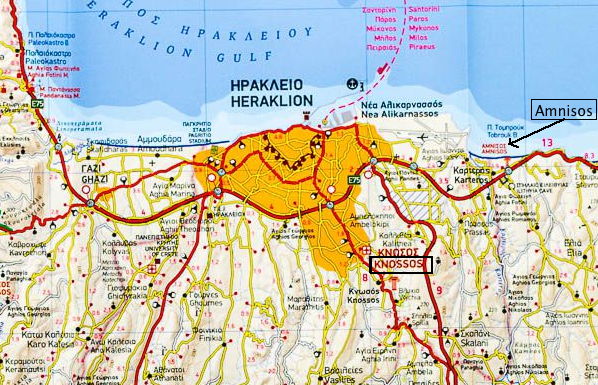
Figure CM601-F2. Location of Amnisos
Amnisos still exists, as a beach quite close to Heraklion Airport, and tourists today can still visit the Eileithyia Cave, just above Amnisos. This cave was used in Minoan religious ceremonies, and has what's described as an altar.
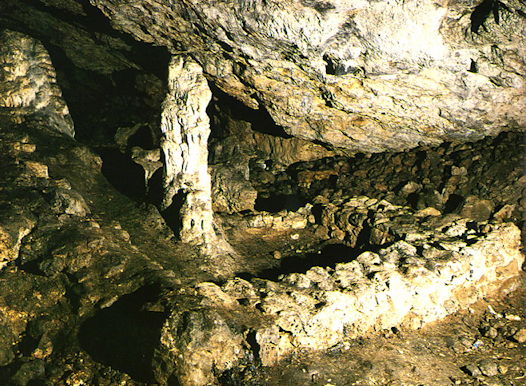
Figure CM601-F3. Inside the Eileithyia Cave. From [5]
Amnisos today
Amnisos today is a beach site, part of the modern Heraklion suburb of Karteros. But in its present position, it could scarcely be considered as the site of a port, even for relatively small ships. What has happened to change it?
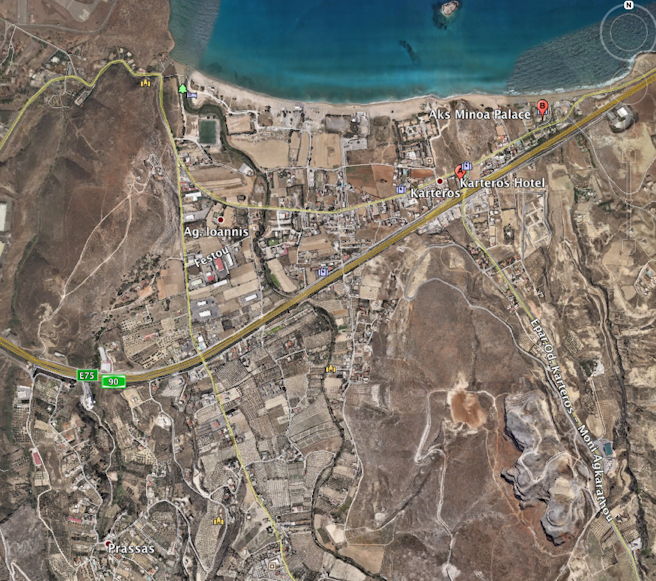
Figure CM601-F4. The beach and hinterlands at Amnisos. From [2].
It is apparent that the present conformation of the Amnisos seafront could not have supported a ship harbour. We will see later that the relationship of land to sea there has changed greatly over the last few thousands of years.
According to [11], Amnisos has been a busy place since Neolithic times. Idomeneus and his 90 ships sailed for Troy from here; here the north wind kept Odysseus's ship in port.
Sorting out the dates
When we look back over the events of the Mediterranean in the centuries before Christ, we have to remember that some events can be dated reasonably closely from modern archaeological evidence while others are rather uncertain. More distant events retreat into historical fiction, even myth, and even well-established dates can be attributed to events which actually occurred at other times.
The best datings are those which can be obtained from Egyptian records. The Egyptians have had writing for thousands of years, back to well before Cretan times, were good record keepers, and the dates for the various dynasties are accurately known.
On the other hand, records which have survived from Minoan Crete are much sparser. The Minoans did have an early script, Linear A, but it has not been deciphered with good certainty, and may have been mostly symbols used to pass invocations to the gods.
Here are some extracts from Britannica [11].
"Linear A and Linear B. Linear forms of writing used by certain Aegean civilizations during the 2nd millennium BC.
Linear A is attested in Crete and on some Aegean islands from approximately 1850 BC to 1400 BC. It is a syllabic script written from left to right. The approximate phonetic values of most syllabic signs used in Linear A are known from Linear B, but the language written in Linear A remains unknown.
Linear B is an adapted form of Linear A, which was borrowed from the Minoans by the Mycenaean Greeks, probably about 1600 BC. Its language is the Mycenaean Greek dialect. Linear B script is attested on clay tablets and on some vases, both dating from about 1400 BC to roughly 1200 BC. The script was exclusively used for the economic administration of the Mycenaean palaces, such as those at Knossos and Khania in Crete, and Mycenae, Pylos, Thebes, and Tiryns in continental Greece.
The Linear B texts are extremely important for Greek linguistics. They represent the oldest known Greek dialect, elements of which survived in Homer's language as a result of a long oral tradition of epic poetry. Linear B was deciphered as Greek in 1952 by Michael Ventris".
Santorini, Atlantis, and the Trojan War
There is no doubt that Santorini, an island about 80 km north of Crete, was mostly destroyed by an immense volcanic explosion around 1500 BC. The explosion was accompanied by giant earthquakes and huge tsunamis, and is thought to have been four times the size of the Krakatoa explosion of 1883 in Indonesia, which killed perhaps 120,000 people and sent shock waves right around the world.
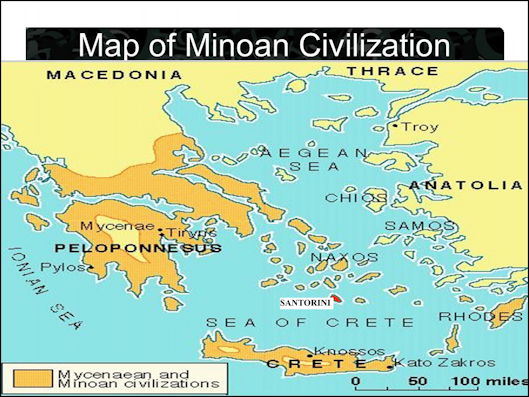
Figure CM601-F5. Minoan civilization. From [9].
The Minoans were a great seafaring nation, and the Santorini event was responsible for the death of their civilization. More detail on the event and its circumstances can be found in the companion article, Minoan Pants [9].
Although centered on Crete, the Minoans had settlements on Santorini and many of the Aegean islands, and also on Peloponnesus, the southernmost part of the mainland of modern Greece. In the latter area, with uplands shielded from the Santorini event, many of the Minoan 'colonials' survived and have become known as the Mycenaeans. And the Mycenaeans were the forerunners of the classical Greeks.
That much is fact. What is still unproved, though with increasing evidence for it (see Gavin Menzies' book The Lost Empire of Atlantis [10]), is that the Santorini event was the basis of the story of the sunken civilization of Atlantis.
The Greek Philosopher Plato told the story of Atlantis around 360 BC [6]. The founders of Atlantis, he said, were half god and half human. They created a utopian civilization and became a great naval power. The lush islands contained gold, silver, and other precious metals and supported an abundance of rare, exotic wildlife. There was a great capital city on the central island.
Plato said Atlantis existed about 9,000 years before his own time, and that its story had been passed down by poets, priests, and others. But Plato's writings about Atlantis are the only known records of its existence.
Another reference in National Geographic [12] says, "About 3,600 years ago, a massive volcanic eruption devastated the island of Santorini in the Aegean Sea near Greece. At the time, a highly advanced society of Minoans lived on Santorini. The Minoan civilization disappeared suddenly at about the same time as the volcanic eruption".
In one version of events, Plato did not hear the original myth of Atlantis, but instead it was told to Solon 300 years prior, who heard it from Egyptian priests who read it from existing texts [7]. Plato heard it from Critias, who is related to Solon, who said it was a story passed down for 3 generations prior to reaching him. Plato's dialogues Timaeus and Critias, written in 360 BC, contain the earliest references to Atlantis.
Another major event of the times was the Trojan War, when a Greek armada sailed to Troy, now believed situated on the Turkish mainland south of the Dardanelles passage to the Black Sea. The Trojan War figured in both of Homer's works, The Odyssey and The Iliad (Ilias or Ileum was another name for Troy, and Trojan is an adjective for Troy).
But even the existence of the Trojan War has been claimed to have been a myth, and if accepted as real, its dates are disputed. The following chart of relevant timelines may clarify the position.
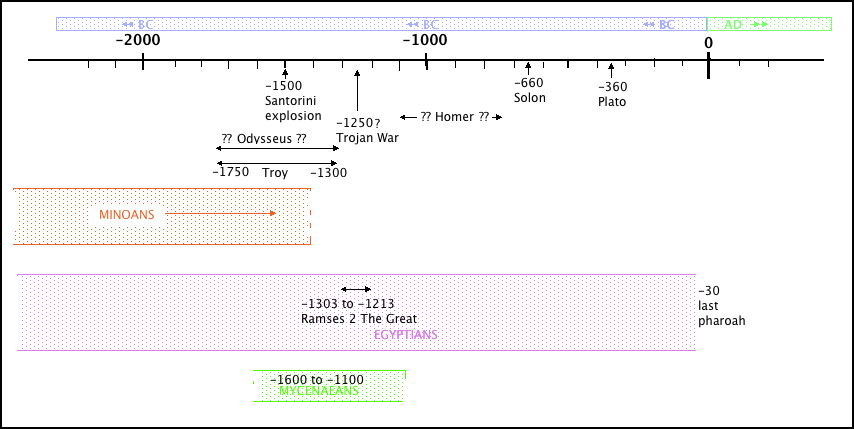
Figure CM601-F6. Timelines for the ancient Mediterranean and Amnisos
In Figure F6, the date given for the Trojan War, 1250 BC, is derived from Egyptian records. But archaeological digs at Troy suggest the city thrived from 1750 BC until it was destroyed by a war in 1300 BC.
The Atlantis -- Trojan War Discrepancy
There is a time-line discrepancy concerning events in the above chart. Suppose we assume for the moment that the story of the destruction of Atlantis which came down to Plato was based on a real event, the explosion of Santorini around 1500 BC (-1500 on the chart). Plato wrote in 360 BC (-360), 1140 years later.
Suppose also that Homer's character Odysseus was based on a real person who had figured in the Trojan War, and that this war did occur around 1250 BC (-1250). Homer's dates are rather shaky, references say only "born sometime between the 12th and 8th centuries BC" (between -1100 and -700).
The difficulty is, that when Odysseus returned in disguise to his wife after the Trojan War, he pretended to be a person called Aethon who was one of the grandsons of King Minos of Crete. The fact that Odysseus was not who he claimed to be is not important. What matters is that King Minos was of an age to be Odysseus' grandfather, yet this would place him before the assumed fall of the Minoans in -1500.
Something has to give. For Odysseus to have known of the Minoan civilization before its fall, he would have had to be active earlier than -1500. From the chart it can be seen that Troy was a thriving city from about -1750. So the conclusion is that Odysseus's Trojan War was not the one which happened in -1250.
This is perfectly possible. Excavations at Troy have revealed the ruins of as many as 9 cities, each built on top of a previous one, and dating back as far as 3000 BC. Cities have been assigned roman numerals, with Troy I running from -3000 to -2600, ending with Troy IX, from -85 to +500 [13]. Homer's Troy is "generally (but not conclusively) identified" with Troy VII [13], that is between -1300 and -1190. But we've seen above that if Odysseus was based on a real character who had known Minoan Crete in its heyday, he would have had to be active before its fall in 1500 BC.
Of course uncertainties and myths pervade all this stuff, but the important point where Amnisos is concerned, is that when it was an active port for the Minoans, this was some 4000 years ago.
Changes in the Amnisos sea-front
Just like many other places currently or formerly on coastal sites, Amnisos has been subjected to forces which have altered the level of the sea relative to the land.
The most general of these forces has been a fall in local sea-levels over time. These falls in sea-level are the opposite of what is supposed to be happening in modern times, but are well evidenced by simply examining the locations of modern and ancient seaports.
Some of these shifts are described in The Rising Sealevel Myth [14]. In one example, I have been able to visit the ruins of the Roman city of Ephesus, close to the modern Turkish city of Selcuk, and walk down to its ancient harbour.
Ephesus was once the second largest city in the Roman Empire, a thriving seaport with a quarter of a million inhabitants. It was partly destroyed by an earthquake in 614 AD [15], and its harbour slowly "silted up", causing it to lose its access to the Aegean. Today the town is some 9 kilometres inland.
Although this "silting up" is conventionally attributed to sediment from a local river, a more realistic reason is that sea-levels along that section of the Turkish coast have fallen appreciably in the last 1400 years. A map in [14] of the area with a 4-metre rise in sea-level shows Ephesus sitting on a wide and sheltered harbour, well able to support the high levels of trade known in Roman times.
Another example in [14] relates to Ur, a great city and seaport of the Sumerian Empire, which flourished from as long ago as 5000 BC. It is said to be where both the wheel and writing were introduced to civilization.
Nowadays, the site of Ur in modern-day Iraq is over 250 kilometres distant from the nearest sea, the Persian Gulf. While silting-up from river sediment may well have occurred, this would be totally inadequate to move a coast this distance. Instead, it appears that the sea has fallen in level some 8 to 10 metres.
Returning now to Amnisos, we can use the elevation feature of Google Earth to trace what the area would have looked like if the local sea-level was 9 metres higher in Minoan times.
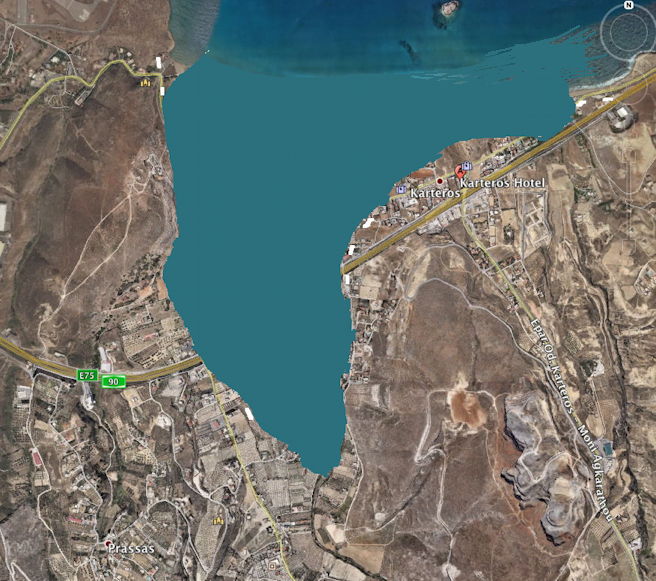
Figure CM601-F7. Amnisos with 9-metre "sea rise"
Comparing Figure F7 with F4, it can be clearly seen that a 9-metre difference in local sea-level would have made Amnisos an attractive harbour, though with the difficulty of sailing out against a northerly wind noted by Homer.
For those interested in why world sea-levels are retreating, this is a consequence of expansion of the Earth. More detail can be found at How Seafloor Spreading affects the level of oceans and seas [19].
Collapse of sea-front land
If world sea-levels are generally receding, how is it that some sea-front sites are still at, or even below, former sea-levels?
The answer is, that many beach sites are in positions where local falls in elevation relative to adjacent land-masses can occur. One example is the New Orleans coast; there, the river sediment which makes up the coastal fringes is slowly settling and compacting under its own weight. This occurs gradually and rather imperceptibly.
But other sea-front collapses occur rapidly, as the result of earthquakes or other abrupt land movements. This is the case with a sunken sea-port off the coast of Alexandria, in Egypt.
Apparently "The city's ruins are located in Abu Qir Bay, originally existing near Alexandria, 2.5 km off the coast and only 10 metres underwater. The city of Heracleion was the gateway to Egypt. It was engulfed by the sea around 1,500 years ago" [16].
A huge earthquake in recent historical times occurred on the coast of Alaska in 1964. This was the largest earthquake ever recorded in North America, and the second largest ever recorded in the world.
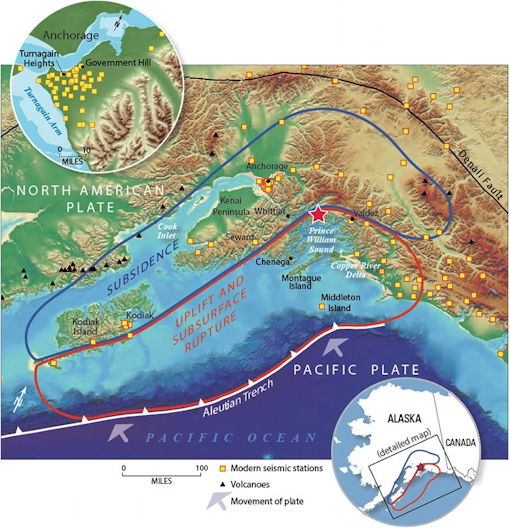
Figure CM601-F8. Alaska in the 1964 earthquake. From [17].
In the Alaska earthquake, vertical displacements of up to 11.5 m occurred [18]. Notice from Figure F8 how the southern Alaska coastal area is poised above the very deep Aleutian Trench, almost like being at the edge of a gigantic cliff -- slippage of the edge of this cliff seems a very possible scenario.
Looking back now at Figure F1, it can be seen how Crete itself is also poised at the edge of a cliff-like structure, above a deep part of the Mediterranean. A localized slippage of 9 metres at the Amnisos coast is clearly possible.
Some of the port installations at Amnisos are still visible today. In the 1930s, while excavating Amnisos's Minoan 'Harbour Master's Office', Spyridon Marinatos discovered a layer of pumice, the evidence he needed to support his theory that Minoan civilization had been devastated by ash from Santorini [11].
Looking again at the Amnisos area shown in Figures F4 and F7, a small islet can be seen at the top of the image. It appears that this islet may have been joined to the main coast in Minoan times by a spit of land, thus improving the shelter of the main harbour, and perhaps bounding a second small harbour to the east.
The levels of items at the Amnisos beach site in earlier times has been investigated by J W Shaw [20]. Here are some extracts from his study.
"In some cases the islands were little more than projecting reefs. In Crete, this was the case at at least three sites, Amnisos, Nirou Khani and Kommos. At the first there is a small islet off the shore, separated from the mainland by shallow water.
It is clear that the relationship was substantially different during Minoan times, since there is at least one Minoan building, with the plan of a house, partly submerged at the shoreline. The Amnisos shoreline was investigated during the 1964-1969 period by Stylianos Alexiou. In 1967 I was asked by him to make a plan of the partially submerged walls, which turned out to be portions of at least three buildings of house type. That the floor level of the houses is now below water level is proved by a submerged threshold still in situ.
At the time that the shoreline house was being used, one can assume that its floor level was at a minimum of 3.00 m higher than now, a figure which can be used as a working estimate of the relative sea level at the time; surely no one would build his house where winter waves would wash up into it. With this in mind, we can postulate a sandy spit leading out to the present islet.
Then, the area east of the peninsula would have been better sheltered than now, even though the beachline would have been significantly further out than now. Still, the approach during windy weather, when the waves can be large, must have caused mariners anxiety. Homer himself describes Amnisos as a difficult harbour"
There is also a local legend apparently about the sinking of this spit. In [21] it notes that "East of the Paleohora Hill, you should visit the wonderful beach of Amnisos. Just 300m north of the beach there is the small island Monocharako where you can go swimming. The best way to reach the islet is by renting a sea pedal in Amnisos. According to local legend the islet was once the tip of a small peninsula that once housed the most powerful city of Crete, ruled by the King Kourkoumelis. One day, the king exclaimed 'No God can demolish such a Great Kourkoumelis!' and suddenly the city sank with the only remnant being that islet!".
* * * * * * * * * * * * * * * * * * * * * * * *

Stablemate articles
Proofs that ocean levels are falling, not rising (countering a new and expensive misconception about the Earth). The Rising Sealevel Myth
How Seafloor Spreading affects the level of oceans and seas -- The Expansion Equilibration Model. Seafloor Spreading.
References and Links
[1]. Minoan civilization. https://en.wikipedia.org/wiki/Minoan_civilization .
[2]. Google Earth. Application. https://www.google.com/earth/download/ge/agree.html .
[3]. Homer: The Odyssey. http://www.poetryintranslation.com/PITBR/Greek/Odyssey19.htm .
[4]. Homer -- Poet -- Biography. http:// www.biography.com/people/homer-9342775.
[5]. Eileithyia Cave. http://www.travelingclassroom.org/wp-content/uploads/2006/07/1eileithyia_cave.jpg .
[6]. Willie Drye. Atlantis—True Story or Cautionary Tale?. http://science.nationalgeographic.com/science/archaeology/atlantis/ .
[7]. Atlantis. https://en.wikipedia.org/wiki/Atlantis .
[8]. Stephen Meher. Khemit And The Myth of Atlantis. http://www.bibliotecapleyades.net/atlantida_mu/esp_atlantida_16.htm .
[9]. David Noel. Minoan Pants -- A fashion item from a very unusual source. http://www.aoi.com.au/Wild/Minoan/index.htm .
[10]. Gavin Menzies. The Lost Empire Of Atlantis: History's greatest mystery revealed. Morrow, 2011.
[11]. Dana Facaros. The Greek Islands. Cadogan Guides, 2007 .
[12]. Atlantis—True Story or Cautionary Tale?. http://science.nationalgeographic.com/science/archaeology/atlantis/ .
[13]. Troy. https://en.wikipedia.org/wiki/Troy .
[14]. David Noel. The Rising Sealevel Myth -- Proofs that ocean levels are falling, not rising (countering a new and expensive misconception about the Earth). http://www.aoi.com.au/bcw/Sealevel/index.htm .
[15]. Ephesus. https://en.wikipedia.org/wiki/Ephesus .
[16]. Archaeologists Find Sunken Egyptian City. http://ancientexplorers.com/blog/abc-news-archaeologists-find-sunken-egyptian-city/ .
[17]. The Great Alaska Earthquake and Tsunami of March 27, 1964. https://en.wikipedia.org/wiki/Atlantis .
[18]. 1964 Alaska earthquake. https://en.wikipedia.org/wiki/1964_Alaska_earthquake .
[19]. David Noel. How Seafloor Spreading affects the level of oceans and seas -- The Expansion Equilibration Model. http://www.aoi.com.au/bcw/Seafloor/index.htm .
[20]. J W Shaw. Bronze Age Aegean Harboursides. https://tspace.library.utoronto.ca/bitstream/1807/3013/2/Bronze%20Age%20Aegean%20Harboursides.doc.pdf .
[21]. Karteros Beach. http://www.cretanbeaches.com/en/sea-tourism/central-crete-beaches-heraklion/karteros-beach .
Go to the Cameos Home Page
Go to the AOI Master Page
First version 1.0 on Web 2016 Aug nn.










